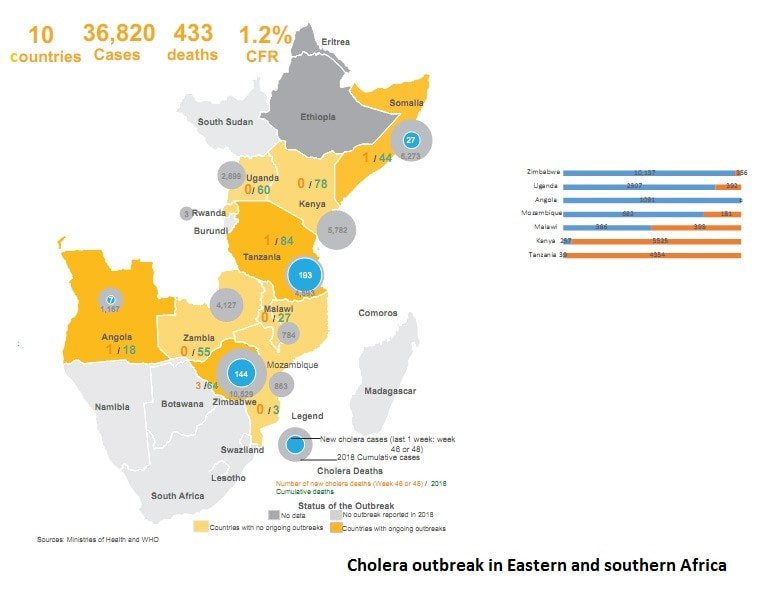|
by Houssem Djeridi Cholera is an acute diarrhoeal infection caused by the bacterium Vibrio cholerae, infecting people most often via contaminated water or food. Every year, cholera causes an estimated 3 to 5 million cases, and 100,000 to 120,000 deaths. The short incubation period (2 hours to 5 days) enhances the potentially explosive pattern of outbreaks. Cholera affects both children and adults and can kill within hours if untreated. it can kill especially those with weakened immune systems within hours if left untreated. Many cases of cholera have been reported in 2018 in different countries: 5 October 2018 (Zimbabwe), 5 October 2018 (Niger), 20 September 2018 (Zimbabwe), 14 September 2018 (Algeria), 14 June 2018 (Cameroon), 29 March 2018 (Somalia), 2 March 2018 (Kinshasa, Democratic Republic of the Congo), 19 February 2018 (Mozambique), 12 January 2018 (United Republic of Tanzania)… In Africa 10 countries have reported more than 36,820 cholera/AWD cases and 433 deaths (Case Fatality Rate, 1.2%), since the beginning of 2018. These countries are: Zimbabwe, Angola, Mozambique, Rwanda, Kenya, Malawi, Somalia, Tanzania, Uganda and Zambia. Zimbabwe, Angola, Tanzania and Somalia have ongoing cholera outbreaks. According to an analysis in seven countries (Angola, Kenya, Mozambique, Malawi, Tanzania, Uganda and Zimbabwe); more cholera cases emerge from urban areas as compared to rural areas. urban areas account for 57.1% (14,899 cases) of the total caseload while rural areas account for 42.9% (11,206 cases) An increase in the epidemic has been noted in Zimbabwe, new cases were reported from Harare (50) and Mt. Darwin district in Mashonaland Central (94 including 3 deaths). Cumulatively, a total of 10,529 cases including 64 deaths have been reported in 2018. The cumulative number of suspected cholera cases reported in Yemen since October 2016 is 1 308 069 including 2 725 related deaths with a case fatality rate of 0.21%. The country experienced a second wave of this outbreak from 27 April 2017. The total number of reported cases of suspected cholera is 1 282 242 including 2 596 related deaths with a case fatality rate of 0.20%, was reported during the second wave. Watery diarrhea can be helpful in identifying cholera because of the rapid spread of the disease. But it is impossible to identify the cholera without testing stool samples, so it is very important to identify cholera because of the potential for a widespread outbreak, For the diagnosis of cholera in laboratories; Gentaur offers kits to isolate and identify Vibrio cholerae serogroup O1 or O139. Check our products here Gentaur povides kits and reagents to isolate and identify Vibrio cholerae serogroups O1 and/or O139 for laboratory diagnosis
0 Comments
Leave a Reply. |
Genprice Inc. USA
(718) 513-2983
[email protected]
Gentaur SRL Italy
02 36 00 65 93
[email protected]
Gentaur GmbH Germany
+49 0241 40 08 90 86
[email protected]
Gentaur Ltd. UK
020 3393 8531
[email protected]
Gentaur Spain
0911876558
[email protected]
Gentaur Sarl France
01 43 25 01 50
[email protected]
Gentaur BV Netherlands
0208-080893
[email protected]
Gentaur BVBA Belgium
0032 265 09 23
[email protected]
Gentaur Sp. z o.o. Poland
058 710 33 44
[email protected]
(718) 513-2983
[email protected]
Gentaur SRL Italy
02 36 00 65 93
[email protected]
Gentaur GmbH Germany
+49 0241 40 08 90 86
[email protected]
Gentaur Ltd. UK
020 3393 8531
[email protected]
Gentaur Spain
0911876558
[email protected]
Gentaur Sarl France
01 43 25 01 50
[email protected]
Gentaur BV Netherlands
0208-080893
[email protected]
Gentaur BVBA Belgium
0032 265 09 23
[email protected]
Gentaur Sp. z o.o. Poland
058 710 33 44
[email protected]





